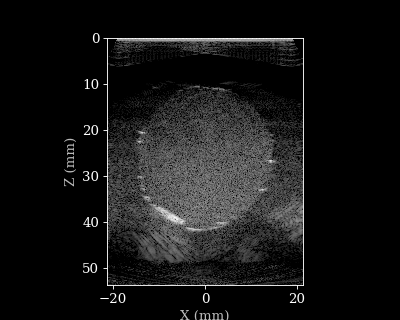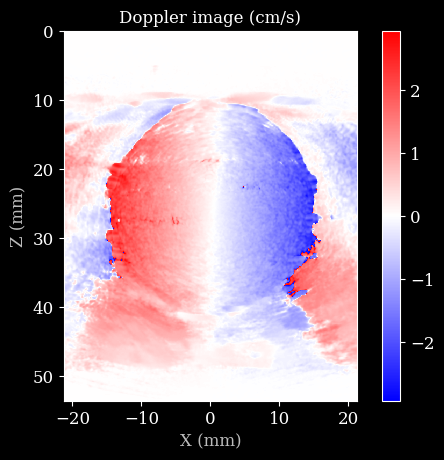Color Doppler Ultrasound¶
In this notebook, we demonstrate how to process and visualize Color Doppler ultrasound data using the zea library. Doppler ultrasound is a non-invasive imaging technique that measures the frequency shift of ultrasound waves reflected from moving objects, such as blood flow in vessels.
[1]:
%%capture
%pip install zea
[2]:
import os
os.environ["KERAS_BACKEND"] = "tensorflow"
os.environ["ZEA_DISABLE_CACHE"] = "1"
We’ll import all necessary libraries and modules.
[3]:
import matplotlib.pyplot as plt
import zea
from zea.doppler import color_doppler
import numpy as np
from zea import init_device
from zea.visualize import set_mpl_style
from zea.internal.notebooks import animate_images
WARNING: All log messages before absl::InitializeLog() is called are written to STDERR
E0000 00:00:1756298636.812776 135582 cuda_dnn.cc:8579] Unable to register cuDNN factory: Attempting to register factory for plugin cuDNN when one has already been registered
E0000 00:00:1756298636.816908 135582 cuda_blas.cc:1407] Unable to register cuBLAS factory: Attempting to register factory for plugin cuBLAS when one has already been registered
W0000 00:00:1756298636.828465 135582 computation_placer.cc:177] computation placer already registered. Please check linkage and avoid linking the same target more than once.
W0000 00:00:1756298636.828481 135582 computation_placer.cc:177] computation placer already registered. Please check linkage and avoid linking the same target more than once.
W0000 00:00:1756298636.828484 135582 computation_placer.cc:177] computation placer already registered. Please check linkage and avoid linking the same target more than once.
W0000 00:00:1756298636.828485 135582 computation_placer.cc:177] computation placer already registered. Please check linkage and avoid linking the same target more than once.
zea: Using backend 'tensorflow'
We’ll use the following parameters for this experiment.
[4]:
n_frames = 25
n_transmits = 10
We will work with the GPU if available, and initialize using init_device to pick the best available device. Also, (optionally), we will set the matplotlib style for plotting.
[5]:
init_device(verbose=False)
set_mpl_style()
Loading data¶
To start, we will load some data from the zea rotating disk dataset, which is stored for convenience on the Hugging Face Hub. You could also easily load your own data in zea format, using a local path instead of the HF URL.
For more ways and information to load data, please see the Data documentation or the data loading example notebook here.
Note that all acquisition parameters are also stored in the zea data format, such that when we load the data we can also construct zea.Probe and zea.Scan objects, that will be usefull later on in the pipeline.
[6]:
with zea.File("hf://zeahub/zea-rotating-disk/L115V_1radsec.hdf5") as file:
scan = file.scan()
# Let's use a little bit less data for this demo
selected_tx = np.linspace(0, scan.n_tx_total - 1, n_transmits, dtype=int)
selected_frames = slice(n_frames)
scan.set_transmits(selected_tx)
data = file.load_data("raw_data", indices=[selected_frames, selected_tx])
probe = file.probe()
B-mode reconstruction¶
First, we will use a default pipeline to process the data, and reconstruct the B-mode image from raw data. Note that the data as well as the parameters are passed along together as a dictionary to the pipeline. By default, the data will be assumed to be stored in the data key of the dictionary. Parameters are stored under their own name. This can all be customized, but for now we will use the defaults.
Note that we first need to prepare all parameters using pipeline.prepare_parameters(). This will create the flattened dictionary of tensors (converted to the backend of choice). You don’t need this step if you already have created a dictionary of tensors with parameters manually yourself. However, since we currently have the parameters in a zea.Probe and zea.Scan object, we have to use the pipeline.prepare_parameters() method to extract them.
[7]:
pipeline = zea.Pipeline.from_default(num_patches=1000, with_batch_dim=True)
params = pipeline.prepare_parameters(probe, scan)
bmode = pipeline(data=data, **params, return_numpy=True)["data"]
I0000 00:00:1756298648.256891 135582 gpu_device.cc:2019] Created device /job:localhost/replica:0/task:0/device:GPU:0 with 42201 MB memory: -> device: 0, name: NVIDIA L40S, pci bus id: 0000:01:00.0, compute capability: 8.9
WARNING: All log messages before absl::InitializeLog() is called are written to STDERR
I0000 00:00:1756298649.261103 135582 service.cc:152] XLA service 0x651262de2f10 initialized for platform CUDA (this does not guarantee that XLA will be used). Devices:
I0000 00:00:1756298649.261153 135582 service.cc:160] StreamExecutor device (0): NVIDIA L40S, Compute Capability 8.9
I0000 00:00:1756298649.302819 135582 cuda_dnn.cc:529] Loaded cuDNN version 90300
I0000 00:00:1756298649.542572 135582 device_compiler.h:188] Compiled cluster using XLA! This line is logged at most once for the lifetime of the process.
Let’s visualize the B-mode images using a helper function.
[8]:
animate_images(bmode, "doppler.gif", scan)

Doppler reconstruction¶
Now, we will create a custom, shorter pipeline that computes the beamformed IQ data, and then computes the Color Doppler image from that. We will use the color_doppler function for this, which computes the Color Doppler image from the IQ data using a simple autocorrelation method.
[9]:
pipeline = zea.Pipeline(
[
zea.ops.Demodulate(),
zea.ops.PatchedGrid([zea.ops.TOFCorrection(), zea.ops.DelayAndSum()], num_patches=10),
zea.ops.ChannelsToComplex(),
],
jit_options="pipeline",
)
[10]:
params = pipeline.prepare_parameters(probe, scan)
output = pipeline(data=data, **params)
data4doppler = output["data"]
Finally, we can visualize the Doppler image using matplotlib!
[11]:
pulse_repetition_frequency = 1 / sum(scan.time_to_next_transmit[0])
d = color_doppler(
data4doppler,
probe.center_frequency,
pulse_repetition_frequency,
scan.sound_speed,
hamming_size=10, # spatial smoothing with Hamming window
)
plt.imshow(d * 100, cmap="bwr", extent=scan.extent * 1e3)
plt.title("Doppler image (cm/s)")
plt.xlabel("X (mm)")
plt.ylabel("Z (mm)")
plt.colorbar()
plt.show()


